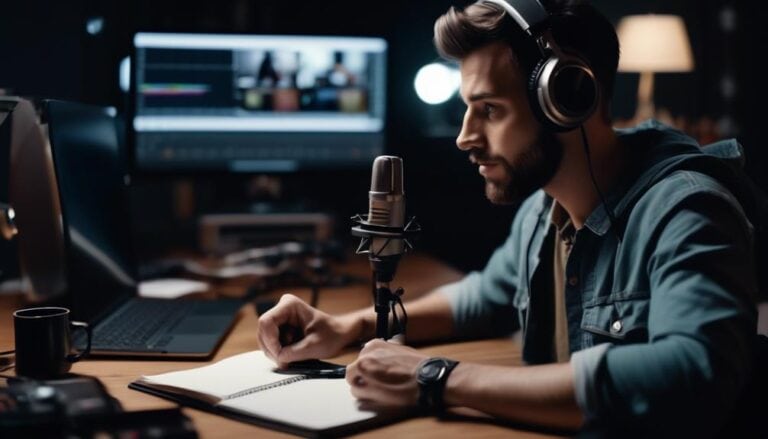Leveraging Editing Software: A Podcaster’s Guide to the Best Audio Tools
When it comes to podcast production, did you know that 85% of podcast listeners believe sound quality is the most important aspect of a podcast? With the rise of podcasting as a popular form of media consumption, ensuring your audio is crisp and clear has become essential.
As a podcaster, you understand the significance of engaging your audience through high-quality content. In this guide, we will explore how leveraging editing software can elevate your podcasting game by providing you with the best audio tools available in the market today.
Key Takeaways
- Efficient workflows are crucial for podcasters, utilize features like cut, copy, paste, and drag-and-drop to streamline tasks.
- Prioritize essential audio editing tools such as noise reduction, multi-track editing, and real-time effects processing for professional results.
- Enhance audio quality through techniques like noise reduction, compression, and equalization to ensure polished sound.
- Optimize editing efficiency by utilizing user-friendly interfaces, customizable shortcuts, and organizing files systematically for seamless navigation.
Benefits of Using Editing Software

When editing podcasts, utilizing editing software can greatly enhance efficiency and quality. Improved efficiency is one of the key benefits of using editing software. With features like cut, copy, paste, and drag-and-drop functionality, tasks that would traditionally take hours can now be completed in minutes. This allows you to focus more on the creative aspects of podcasting rather than getting caught up in tedious editing processes.
Enhanced creativity is another advantage of using editing software. Most audio editing tools offer a wide range of effects, filters, and tools that can help you manipulate sound in unique ways. From adjusting pitch and tempo to adding reverb and distortion, the possibilities for creative expression are endless. By experimenting with different effects and techniques, you can take your podcast to new heights and captivate your audience with engaging audio content.
Top Features to Look For
When choosing audio editing software, you should prioritize essential tools like cutting, fading, and equalizing for precise editing.
Look for a user-friendly interface that streamlines your workflow, making editing tasks efficient and intuitive.
Additionally, consider software that offers audio enhancement options such as noise reduction and audio effects to polish your podcast recordings.
Essential Editing Tools
Consider incorporating key features like multi-track editing, noise reduction tools, and real-time effects processing when selecting audio editing software for your podcast production needs. To achieve professional results and streamline your editing process, look for these essential tools:
- Multi-track editing: Enables you to work on multiple audio tracks simultaneously, allowing for precise editing and seamless integration of various elements.
- Noise reduction tools: Essential for cleaning up background noise and ensuring a clear, polished sound quality in your podcast episodes.
- Real-time effects processing: Provides the capability to apply effects like reverb, equalization, and compression while listening to the audio in real-time, allowing for immediate adjustments and fine-tuning.
These features will help you implement advanced techniques and achieve professional results effortlessly.
User-Friendly Interface
Look for audio editing software that offers an intuitive interface designed for seamless navigation and efficient editing workflows. A user-friendly interface should allow for interface customization, enabling you to arrange tools and features to suit your preferences.
Quick shortcuts are essential for speeding up your editing process, so look for software that allows you to customize or create shortcuts for frequently used functions. Visual waveform representation is crucial for precise editing, as it provides a detailed visual overview of your audio file.
Seamless navigation within the software helps you move between different sections of your project easily, enhancing your overall editing experience. Prioritize an interface that allows for customization, quick shortcuts, visual waveform display, and seamless navigation to optimize your podcast editing workflow.
Audio Enhancement Options
For optimal audio quality in your podcasts, prioritize audio editing software that offers advanced enhancement options tailored for professional-grade results. When selecting software, look for the following key features:
- Noise reduction, equalization: Advanced noise reduction tools can help eliminate background distractions, while equalization allows you to fine-tune frequencies for clarity and balance.
- Compression, normalization: Compression helps control the dynamic range of your audio, ensuring consistent volume levels, while normalization adjusts the overall volume to a standard level without affecting the dynamic range.
- Reverb reduction: This feature helps reduce reverberation in recordings, making your audio sound more polished and professional.
Choosing software with these features will elevate the sound quality of your podcasts and enhance the listening experience for your audience.
Popular Editing Software Options
When choosing an audio editing software, you want to consider the top options available that offer a range of features for podcast production.
Comparing the features of different software can help you determine which one aligns best with your editing needs.
Look for user-friendly interfaces that will make the editing process smooth and efficient.
Top Editing Software
Among the myriad of audio editing software available, a select few stand out as the top choices for podcasters seeking professional-quality results. When it comes to unleashing your creativity and mastering advanced techniques, these tools are essential for taking your podcast to the next level:
- Adobe Audition: Known for its robust features and seamless integration with other Adobe products, Audition is ideal for podcasters looking to apply advanced editing techniques.
- Audacity: This open-source software is favored for its simplicity and wide range of creative effects, making it perfect for beginners and experienced podcasters alike.
- Logic Pro X: Offering a suite of professional tools, Logic Pro X is a favorite among Mac users for its versatility in implementing advanced editing techniques and creative effects.
Features Comparison
After exploring the top editing software options for podcasters, the next step is to compare the features of these popular choices to determine which best suits your editing needs. When considering advanced automation features, some software like Audacity offers extensive capabilities for batch processing and repetitive tasks. On the other hand, Adobe Audition provides a more streamlined approach with its advanced scripting options. In terms of seamless integration capabilities, GarageBand excels in its compatibility with other Apple products and iCloud storage, while Hindenburg Journalist stands out for its easy integration with publishing platforms like Libsyn. By evaluating these features, you can select the editing software that aligns best with your workflow and requirements.
| Software | Advanced Automation Features | Seamless Integration Capabilities |
|---|---|---|
| Audacity | Extensive batch processing | Moderate integration capabilities |
| Adobe Audition | Advanced scripting options | Good compatibility with Adobe CC |
| GarageBand | Limited automation features | Excellent integration with Apple |
User-Friendly Interfaces
For podcasters seeking editing software with user-friendly interfaces, navigating options like Hindenburg Journalist, Audacity, and Adobe Audition can streamline the editing process efficiently. When considering user-friendly interfaces, these software options stand out for their navigation simplicity and quick access to essential tools.
Here's why they're favored by many podcasters:
- Hindenburg Journalist:
- Intuitive design that allows for easy navigation through the editing process.
- Audacity:
- Efficient controls that enable quick editing and adjustment of audio tracks.
- Adobe Audition:
- User-friendly interface with features that facilitate a smooth editing workflow.
Tips for Efficient Editing Workflow
Optimize your editing process by streamlining tasks and utilizing keyboard shortcuts to enhance efficiency in your audio editing workflow. Keyboard shortcuts are invaluable time-saving techniques that can significantly speed up your editing process. Familiarize yourself with key combinations for common functions like cutting, pasting, and adjusting audio levels. This will help you work faster and with more precision.
Consider using collaboration tools for seamless remote editing options. Platforms like Google Drive or Dropbox allow you to share files with collaborators in real-time, making it easier to work on projects together, even when you're not in the same location. Utilizing these tools can streamline your workflow and improve overall productivity.
When editing, organize your files systematically to avoid wasting time searching for specific audio clips. Create folders for different episodes, segments, or types of audio to keep everything neatly categorized. This simple step can save you valuable time and ensure a more efficient editing process. By implementing these tips, you can maximize your editing workflow and produce high-quality podcast content with ease.
Enhancing Audio Quality With Tools

To enhance the quality of your audio, consider utilizing a range of specialized tools designed to refine and optimize sound clarity and consistency. When aiming to achieve pristine audio clarity and reduce unwanted noise in your podcast recordings, the following tools can be instrumental in elevating the overall listening experience:
- Equalizers: Adjust the frequency balance of your audio, allowing you to boost or cut specific bands to enhance clarity and remove any muddiness in the sound.
- Noise Reduction Plugins: Utilize advanced algorithms to identify and suppress background noise, hums, or hisses, ensuring a cleaner audio output free from distractions.
- Compressors: Control the dynamic range of your audio by smoothing out volume fluctuations, resulting in a more consistent sound level and improved overall clarity throughout your podcast episodes.
Maximizing Post-Production Techniques
When enhancing audio quality with specialized tools to refine sound clarity and consistency, the next step involves maximizing post-production techniques to further polish and perfect your podcast recordings. To achieve professional results and master audio, consider implementing advanced techniques in your post-production workflow. By fine-tuning the following aspects, you can elevate the quality of your podcast:
| Post-Production Technique | Description | Benefit |
|---|---|---|
| Noise Reduction | Use noise reduction tools to eliminate background noise and enhance clarity. | Improves sound quality by reducing distractions. |
| Equalization (EQ) | Adjust EQ settings to balance frequencies and enhance tone quality. | Enhances overall sound clarity and richness. |
| Compression | Apply compression to even out audio levels and increase overall volume consistency. | Ensures a more balanced and professional sound. |
Frequently Asked Questions
Can Editing Software Help With Removing Background Noise and Improving Overall Audio Quality?
Yes, editing software can be a powerful tool for enhancing your audio content. By utilizing features such as noise reduction algorithms and audio enhancement tools, you can effectively remove background noise and significantly improve the overall quality of your recordings.
Are There Any Specific Editing Software Options That Are Better Suited for Beginners Versus Advanced Users?
For beginners, user-friendly editing software like Audacity or GarageBand offer basic features like simple editing tools and intuitive interfaces. Advanced users may prefer more comprehensive options such as Adobe Audition or Pro Tools for advanced editing capabilities.
How Can Editing Software Help Streamline the Podcast Editing Process and Save Time?
To save time and streamline your podcast editing process, use time-saving techniques like keyboard shortcuts, batch processing, and templates. Optimize your workflow with efficient organization tips such as color-coding tracks and creating presets.
Are There Any Editing Software Tools or Features Specifically Designed for Enhancing Voice Clarity and Reducing Distortion?
To enhance voice clarity and reduce distortion, consider using editing software tools like noise reduction filters, EQ adjustments for frequency balance, and de-essers for sibilance control. These features can significantly improve the overall audio quality.
Can Editing Software Help With Adding Music and Sound Effects to a Podcast Episode?
Yes, editing software can enhance your podcast by adding ambiance and sound effects, creating an immersive experience that engages listeners. By incorporating music and effects strategically, you can elevate storytelling and captivate your audience.
Conclusion
In conclusion, leveraging editing software is essential for podcasters to enhance their audio quality, streamline their editing workflow, and maximize post-production techniques.
By utilizing the top features of popular editing software options, podcasters can efficiently create high-quality content that engages their audience.
Remember to always prioritize audio quality and explore different tools to achieve the best results in your podcast production process.
Stay organized, stay creative, and keep pushing the boundaries of your podcasting capabilities.








